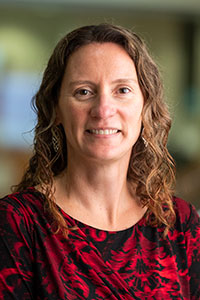Stem cell research holds great potential for regenerative therapies and treatments to combat cardiovascular disease, which is responsible for over 30 percent of all deaths worldwide.
Highly functional cardiomyocytes—the muscle cells responsible for the contraction of the heart—are important for disease modeling, drug screening, and other regenerative medicine approaches.
However, the process of differentiating stem cells into cardiomyocytes is costly, labor-intensive, and highly variable.

“There’s this need for quality control in stem cell differentiation, for scale-up for industrial applications,” says Morgridge Institute for Research Investigator Melissa Skala.
In a new study published today in the journal Nature Communications, the Skala Lab developed a non-invasive imaging technique that can predict the efficiency of cardiomyocyte differentiation as a method of quality control.
“If we can predict the outcome of stem cell differentiation into cardiomyocytes at a very early stage, then we can save time, money, and speed at the manufacturing stage,” says Tongcheng Qian, lead author and assistant scientist in the Skala Lab.
It takes about 14 days for human pluripotent stem cells to differentiate into cardiomyocytes, during which the cells have drastic changes in metabolic activity.
The researchers measured autofluorescence of NAD(P)H and FAD, two molecules that are involved in cellular metabolism, at various timepoints throughout the differentiation process. Since this method uses the innate autofluorescence of the cells, it is non-invasive and can be performed in real-time without damaging the cells.

While there have been many studies that look at metabolic changes during stem cell differentiation, Qian and Skala say the predictive modeling of their research is important.
“For applications or biomanufacturing, we can then intervene at early timepoints to change media conditions or change confluency to improve the outcome,” says Skala, also a professor of biomedical engineering at the University of Wisconsin–Madison.
The team saw metabolic changes as early as day 1, with low versus high differentiation efficiency conditions.
Qian collected the imaging data from tens of thousands of cells, and then passed on the data to co-first author Tiffany Heaster, who now works at Genentech after earning her PhD through the Skala Lab.
“It’s a simple logistic regression model,” says Skala. “But Tiffany built it in a rigorous way with separate testing and validation; all the checks you need to do robust science.”
Qian says that in the future, he’d like to incorporate more factors into the model to have a really precise prediction.
“Just to deal with the reproducibility of that data was actually very impressive,” Skala adds. “And it was completely consistent with data taken two years previously; I was like ‘science works!’ and it makes you feel a lot more confident about what you’re seeing.”
The researchers hope that this work provides the framework for how the imaging technique could be applied at a larger scale for bulk manufacturing.

“Cardiomyocytes can be differentiated in a suspension culture, too,” says Qian. “If we do differentiation in suspension, or organoid differentiation, then it’s more like an industry manufacturing scale.”
He says that in the future, he’d also like to try to see their autofluorescence technology applied to predicting other cell lineage differentiation, like immune cells or blood cells, which could have other applications.
The project was a perfect example of how scientific ideas are born from collaboration, with Qian’s interest in stem cells and his background in chemical engineering paired with Skala’s expertise in optical imaging.
“This project was done by a lot of collaboration. It’s a team effort,” Qian says in appreciation of Heaster who did the predictive modeling, and the undergraduates and lab members who assisted with analysis.
Skala adds: “It’s a combination of expertise, which is what we love about science.”
Read more from the researchers in their Nature Communications “Behind the Paper” feature.
